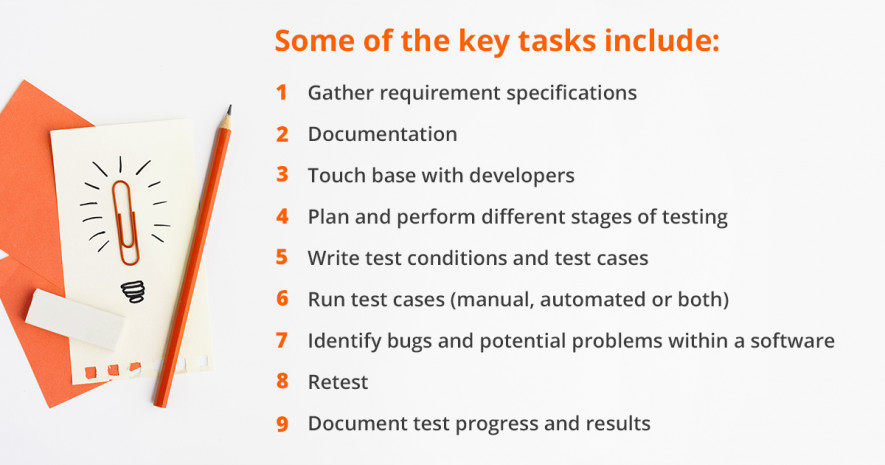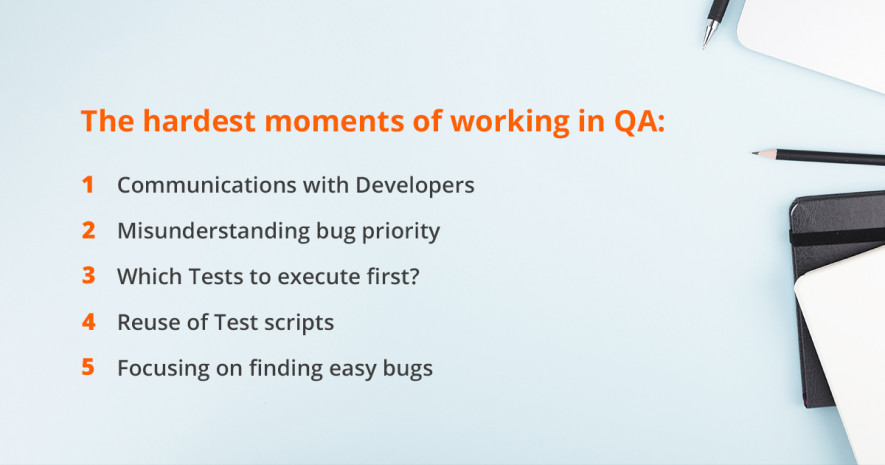- QATestLab Blog >
- QA Life >
- Bug Busters: A day in the life of QA Engineer
How does the process of finding errors, failures, and bugs look like? What do QA engineers do during their working hours? We found the time to ask specialists from QATestLab about life as a QA engineer, and the challenges they face.
This article will be especially useful for beginners and just curious minds who make their first steps towards QA engineering. It will also be valuable for Test Leads, and anyone who collaborate with testers but have a rather vague idea about this job. Let’s look behind the curtain of this superhero position and understand the essence of this job better.
Testing Process: Daily tasks & Responsibilities

The life of a tester is quite dense – most testers spend much of their time writing test cases and thinking on how to “break” the system and reveal all the possible bugs. But right under the surface, there are other responsibilities too. Living a life as a tester insistence solid effort and consistent focus for thinking, researching, testing, and sometimes even coding. Still, a lot of people are under the misapprehension about it. Let’s look at what testers say about it.
Q: What is a typical day in the life of a tester?
In a nutshell, the day of a tester consists of three things:
- Scrum Meetings: At QATestLab, we start our day with morning stand-up meetings within a team working on a specific project. We discuss all the problems and obstacles that are blocking progress. All these go hand in hand with checking tickets on Jira, which is the tool for organizing tasks.
- Teamwork: If talking about QATestLab, the vast majority of our projects are performed collaboratively. Right now, we have five different programs, according to which we form our teams and improves the efficiency of working in more narrow directions. During a typical working day, we communicate a lot within a team and discuss all the possible situations.
- Testing Stuff: The main part of a typical tester’s day is spent on creating or updating test cases. If to go deeper, these tasks are consist of conducting manual testing and analyzing whether some tasks can be automated. In the latter case, we build out an automation framework and send this task to a backlog of automation. If there is a possibility that test cases can fail, we talk to the task’s developer and re-open an issue to bring into our workload.
Q: Do testers literally sit in front of a computer and find bugs?
Finding bugs is rather a broad concept. As we mentioned earlier, we spend lots of our time communicating with other QA engineers. Apart from this, we read or write documentation, touch base with developers. As for the testing itself, we plan and perform different stages of testing, write test conditions, run test cases (manual, automated, or both), and if there is a need, we retest application again.

Q: What attributes/skills make a tester successful?
Software testing is not rocket science yet it requires having some background of computer science or STEM degree. On the other hand, it is not a must, ‘cause success depends only on your skills and passion for improving in this direction.
Q: How has the tester role changed in recent years?
Just as software development is evolving rapidly, the field of testing is also not standing still. Being a tester demands constant following all the updates and the news. We need to understand what is currently most relevant both for developers and users. Accordingly, our tools and methodology are also changing. For example, more and more tasks can be automated. New scriptless testing tools are arriving that do not require programming skills.
Challenges Faced By Testers during their working hours
The lifecycle of QA engineer is fascinating yet is not without problems. What’s the hardest part of the tester’s job? We can highlight several points:

#1 Communication with Developers
Professional tension during tester-developer communication is still a sore point for many. To avoid racking developer’s brains, a tester needs to have empathy and a considerable amount of tact to find appropriate words to describe all the errors and failures of a product. We at QATestLab strive to approach these issues as a team and find the most effective solutions together.
#2 Misunderstanding bug priority
Another one big question mark in the life of a tester is the wrong understanding of the bug priority. As a rule, this problem is faced by Project Managers who can’t see the whole picture of all bugs at once and point out the urgent tasks. In situations like this, it’s essential to stick to intuition. What’s more, PM shouldn’t forget they are part of a team.
#3 Which Tests to execute first?
Unfortunately, QA engineers can’t run all the tests in the nick of time. Everything should be performed step by step, and for this, we need to know the right sequence of these steps. Which tests have a bigger priority? To answer a question like this, you need to have an excellent experience to work under pressure.
#4 Reuse of Test scripts
Test script migration or reuse is an essential yet complex task. All the existed methods are changing rapidly. With this in mind, it is difficult to manage all the test tools and test scripts. You need to constantly adapt and adjust to new stuff all the time.
#5 Focusing on finding easy bugs
Last but not least problem. Lots of testers have the wrong aim to catch the biggest amount of bugs. Such an approach leads to an inefficient process of testing. Let’s not forget the main task of a tester is not to find lots of bugs but to ensure software quality. Quality is not equaled to quantity.
So, all-in-all, if you are always striving to find new approaches, all of the problems described above can be easily solved. You just need to keep in mind possible pitfalls.
Bottom line: The value of tester’s job
To be a tester means you are on the bright side. You contribute to the successful releasing of a product, you make a user be happy using a quality application. The key value of the testers’ job is not only the early identification of bugs to make programs produce expected results but also to saving time and money in the long run.
Learn more from QATestLab
Related Posts:
About Article Author
view more articles
has more than 2-year experience in blogging and copywriting, copyediting and proofreading of web content.
View More Articles







No Comments Yet!
You can be the one to start a conversation.